Feijoada Brasileira: Brazil’s Legendary Black Bean Stew That Warms the Soul 🇧🇷🥘✨
1. Introduction
Feijoada Brasileira is more than just a dish – it’s a cultural institution, a celebration of Brazilian heritage passed down through generations, and the ultimate comfort food that brings families together around the table. This rich, hearty black bean stew loaded with tender pork cuts and smoky sausages has been warming hearts across Brazil for centuries, with roots tracing back to the colonial period when enslaved Africans adapted European cooking techniques with local ingredients.
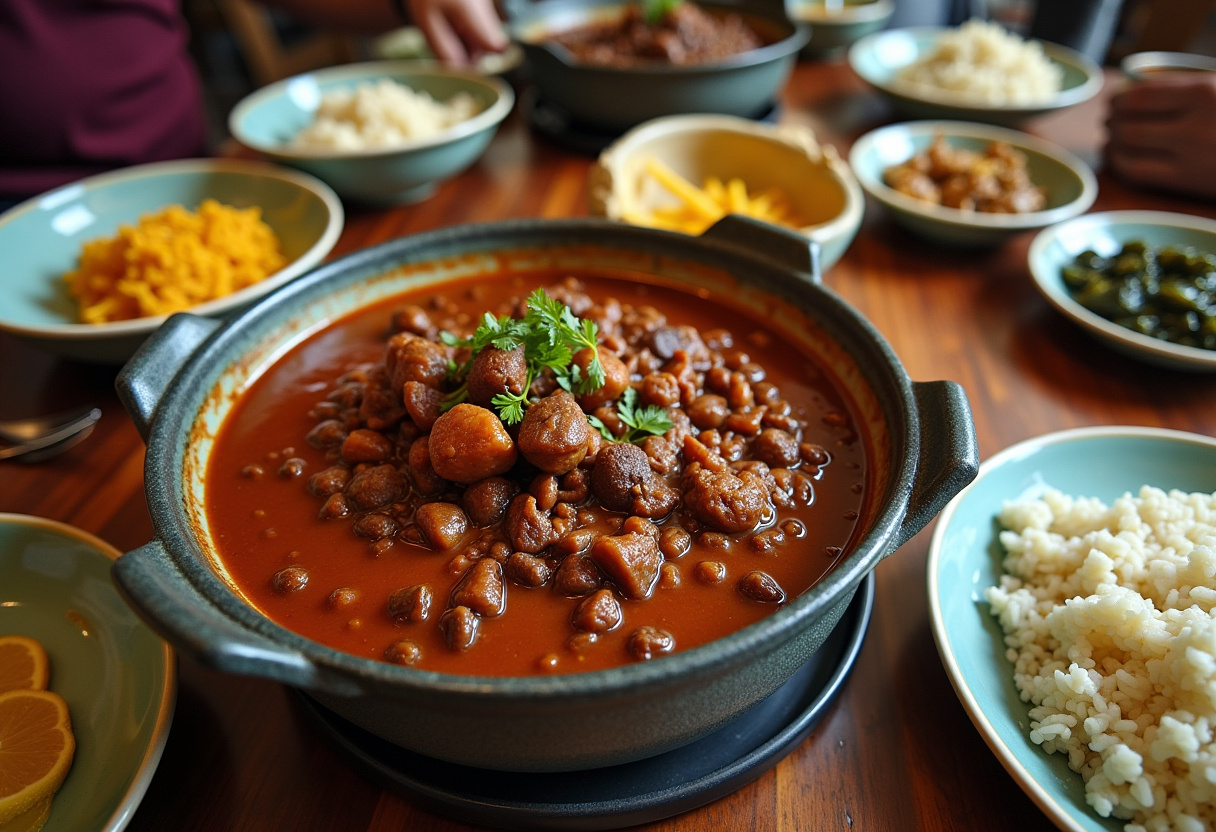
Our authentic feijoada brasileira recipe captures the soul of this beloved dish with slow-cooked black beans, multiple cuts of pork, and that unmistakable smoky depth of flavor that makes it so special. Traditionally served on Saturdays with all the fixings – fluffy white rice, garlicky collard greens, bright orange slices, and crunchy farofa – this is Brazilian comfort food at its finest. The dish is so iconic that many Brazilian families consider it a weekend ritual, often gathering for leisurely feijoada lunches that stretch into the afternoon.
2. Ingredients
Creating an authentic feijoada brasileira requires quality ingredients and a variety of pork cuts to achieve that signature depth of flavor. Here’s what you’ll need:
- 2 cups dried black beans (soaked overnight – look for beans with shiny, unbroken skins)
- 1 lb pork shoulder (cut into 2-inch chunks – the marbling makes it perfect for slow cooking)
- 1 lb smoked pork ribs (meaty ribs with good fat content)
- 1/2 lb Brazilian calabresa sausage (or substitute chorizo if unavailable – the smokiness is key)
- 1/2 lb smoked bacon (in one piece – preferably thick-cut with good fat layers)
- 1 large onion (chopped – yellow onions work best for sweetness)
- 4 garlic cloves (minced – fresh is essential for authentic flavor)
- 2 bay leaves (fresh if possible, otherwise dried works)
- 1 orange (quartered – use navel oranges for sweetness)
- 8 cups water (or homemade pork stock for extra richness)
- Salt and pepper to taste (coarse sea salt recommended)
- 2 tbsp olive oil (extra virgin for best flavor)
For those looking to explore more Brazilian culinary traditions, check out this authentic feijoada recipe from Brazil’s most popular cooking site.
3. Step-by-Step Instructions
Step 1: Prepare the Meats
In a large heavy pot (preferably cast iron or enameled Dutch oven), heat olive oil over medium heat until shimmering. Working in batches to avoid overcrowding, brown the pork shoulder chunks on all sides until golden (about 3-4 minutes per side), then remove and set aside. Add the ribs and bacon piece, browning them lightly (about 2 minutes per side for ribs, 3 minutes for bacon). Remove and set aside with the pork shoulder. Finally, brown the sliced calabresa sausage for about 2 minutes per side until lightly caramelized – this builds incredible flavor layers.
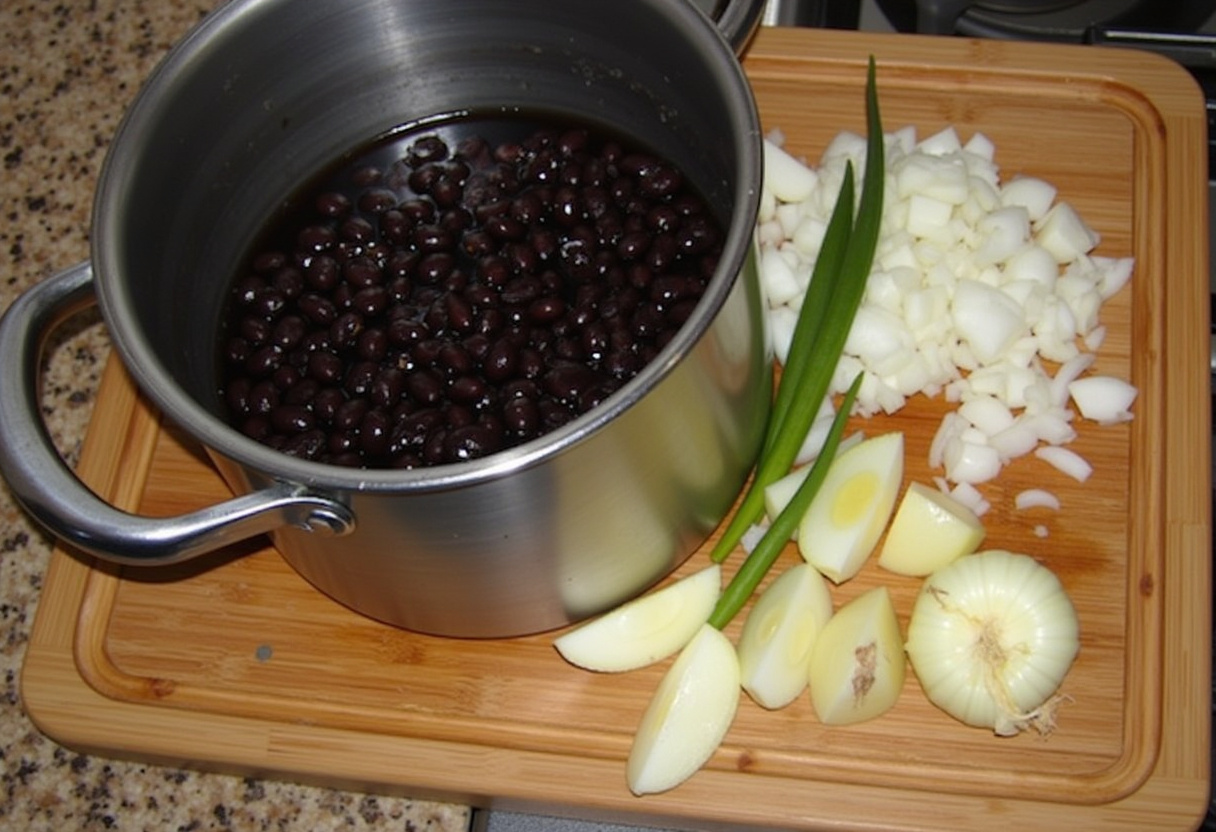
Step 2: Build the Flavor Base
In the same pot (don’t wash it – those browned bits are flavor gold!), sauté the chopped onion over medium-low heat until translucent and slightly golden (about 5-7 minutes). Add the minced garlic and cook for another minute until fragrant but not browned – this prevents bitterness. Return all the meats to the pot along with the soaked (and thoroughly drained) black beans, bay leaves, and orange quarters. The orange might seem unusual, but it adds a subtle brightness that cuts through the richness. Pour in 8 cups of water (the liquid should cover everything by about an inch) and bring to a gentle boil, skimming off any foam that rises to the surface during the first 10 minutes of cooking.
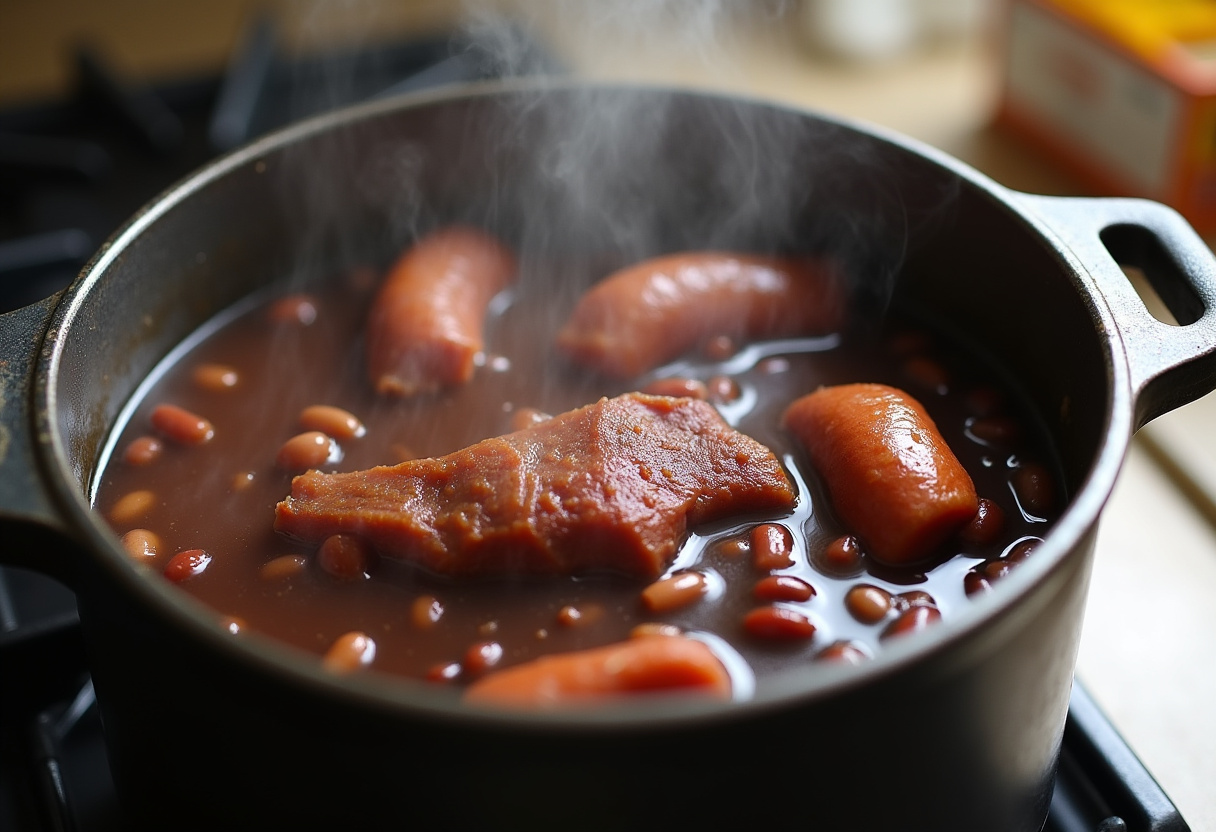
Step 3: Slow Simmer to Perfection
Reduce heat to low (you want just the occasional bubble breaking the surface), partially cover (leave about an inch open for steam to escape), and simmer gently for 2-3 hours, stirring occasionally and checking that the liquid doesn’t reduce too much. The beans should become creamy while the meats become fall-off-the-bone tender. About halfway through (after 90 minutes), remove the bacon piece, slice it into bite-sized pieces, and return it to the pot. This technique ensures the bacon maintains some texture rather than completely disintegrating. Season with salt and pepper to taste – be generous but remember you can always add more later. The stew should be thick but still soupy – if it gets too thick, add hot water in 1/2 cup increments.
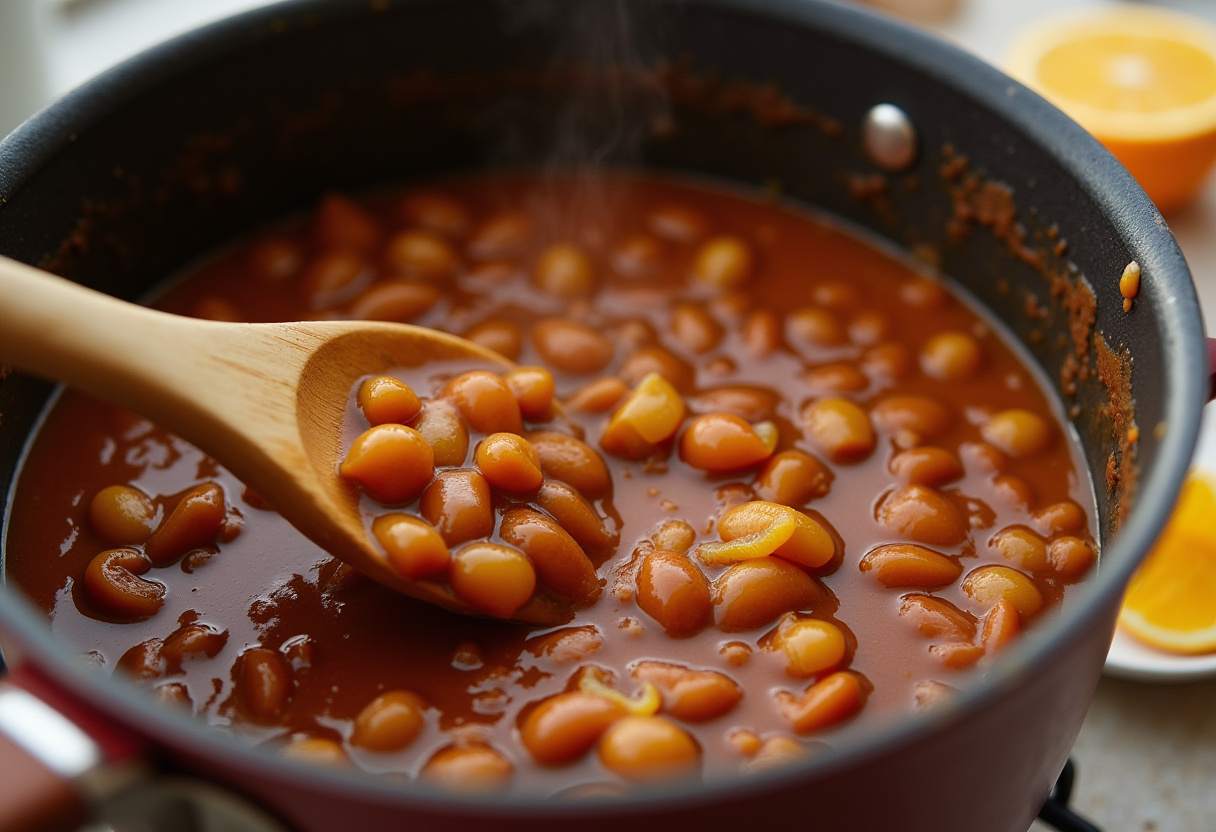
Step 4: Serve with Traditional Accompaniments
Remove bay leaves and any remaining orange pieces before serving (they’ve done their job). Ladle the feijoada brasileira into wide, shallow bowls over a bed of fluffy white rice – the rice acts as the perfect canvas for the rich stew. Traditional accompaniments include: sautéed collard greens (couve) thinly sliced and quickly cooked with garlic, fresh orange slices (the vitamin C helps absorb iron from the beans), farofa (toasted cassava flour that adds delightful crunch), and a fiery hot pepper sauce for those who like heat. Some Brazilian families serve a small bowl of the broth (caldinho) on the side for sipping or pouring over rice. For more international dinner inspiration, explore our collection of global dinner recipes.
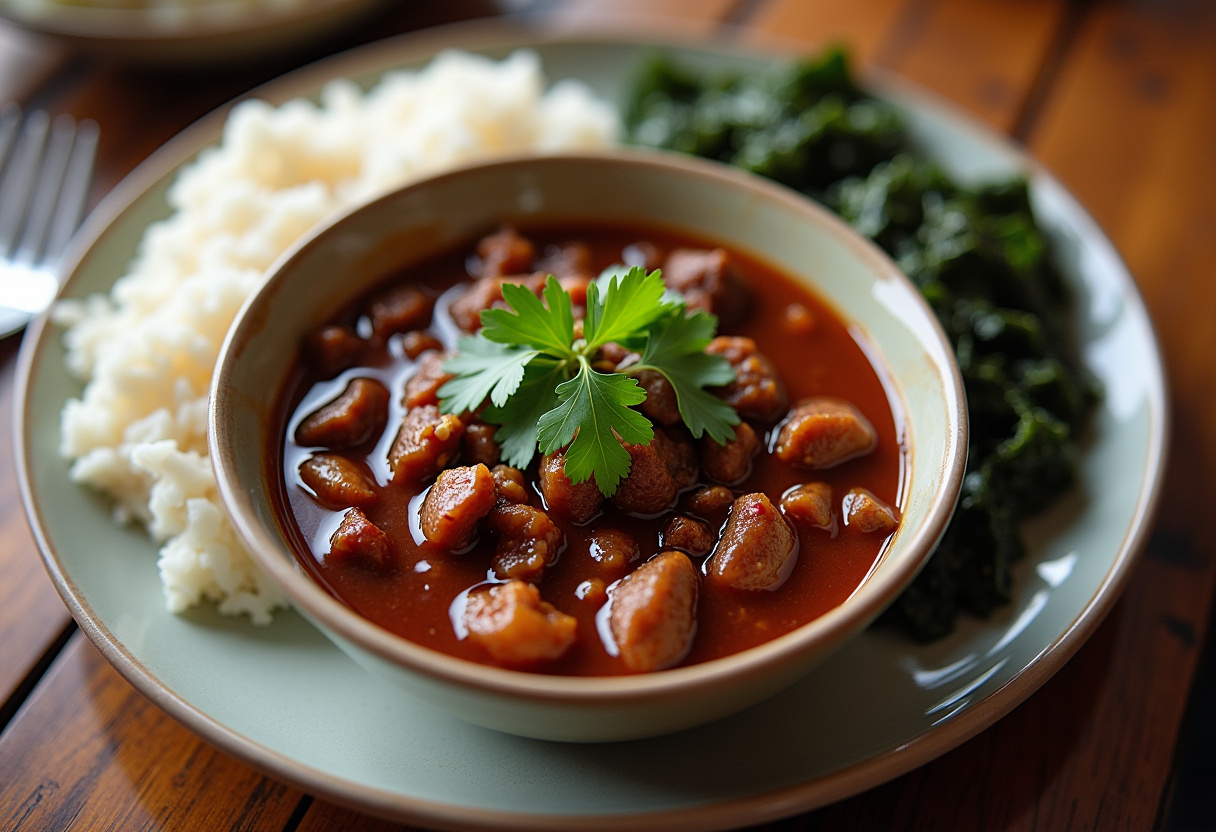
4. Cooking Tips
- Meat selection is crucial: For authentic flavor, use at least three different pork cuts (ribs for richness, shoulder for tenderness, and sausage for smokiness)
- Bean preparation matters: Soaking beans overnight not only reduces cooking time but also helps achieve that perfect creamy texture without splitting
- Acidity balances richness: The orange adds subtle acidity that brightens the dish – don’t skip it!
- Flavor development: Feijoada tastes even better the next day as flavors meld – consider making it a day ahead
- Consistency control: If the stew gets too thick, add hot water to adjust – it should coat the back of a spoon but still flow
- Skimming is key: Regularly skim foam and excess fat during cooking for cleaner flavor
5. Variations
- Vegetarian Feijoada: Substitute pork with smoked tofu, portobello mushrooms, and roasted sweet potatoes – add liquid smoke for depth
- Quick Feijoada: Use canned black beans (rinsed well) and pre-cooked meats (reduce simmer time to 30 minutes) – great for weeknights
- Seafood Feijoada: Coastal version with shrimp, firm white fish, and squid – use fish stock and add seafood in last 10 minutes
- Feijoada Light: Use leaner cuts like pork loin and turkey sausage – boost flavor with extra garlic and smoked paprika
- Regional Variations: In Minas Gerais, they add kale; in Bahia, dendê oil gives a distinctive flavor
6. Serving Suggestions
- Signature cocktail: Caipirinha cocktails (made with cachaça, lime, and sugar) make the perfect pairing
- Appetizer idea: Serve with Brazilian cheese bread (pão de queijo) as an appetizer while the feijoada simmers
- Heat options: Offer molho de pimenta (Brazilian hot sauce) and malagueta peppers for spice lovers
- Fresh contrast: A crisp green salad with lime vinaigrette balances the richness
- Dessert pairing: Finish with brigadeiros (Brazilian chocolate truffles) or passion fruit mousse
7. Storage & Reheating
- Refrigeration: Store in airtight containers for up to 4 days – the flavors actually improve over 2-3 days
- Freezing: Freeze portions for up to 3 months (beans may soften slightly upon thawing)
- Reheating: Reheat gently on stove with a splash of water to prevent drying – microwave tends to make beans mealy
- Safety tip: Bring reheated feijoada to a full boil for food safety
- Reviving leftovers: Add a splash of orange juice when reheating to refresh flavors
8. Frequently Asked Questions
Is feijoada brasileira spicy?
Traditional feijoada isn’t inherently spicy, but Brazilians always serve it with hot pepper sauce (molho de pimenta) and sometimes fresh malagueta peppers on the side for those who want heat. The stew itself relies more on smoky, savory flavors from the various pork cuts rather than chili heat.
Can I make feijoada in a pressure cooker?
Absolutely! A pressure cooker cuts the cooking time significantly. Cook soaked beans with tougher meats (ribs, shoulder) under pressure for 30 minutes, then release pressure naturally before adding sausages and simmering uncovered for 15 minutes to meld flavors. The texture will be slightly different but still delicious.
What’s the best cut of pork for feijoada?
Pork shoulder (also called pork butt) is ideal because its marbling and connective tissue break down during long cooking, becoming incredibly tender while flavoring the beans. Other excellent options include pork hocks, trotters, or ears for extra collagen, and smoked pork products like ribs or bacon for depth.
Why oranges with feijoada?
The tradition serves multiple purposes: the vitamin C helps the body absorb iron from the beans, the acidity cuts through the dish’s richness, and the bright flavor provides a refreshing contrast. Some cooks even squeeze orange juice into their bowl while eating. Historically, oranges were also believed to aid digestion of the heavy meal.
Is feijoada only eaten on Saturdays?
While Saturday is the traditional feijoada day in Brazil (giving people time to digest before Monday work), you’ll find it served throughout the week in restaurants and homes. The Saturday tradition stems from its historical preparation by enslaved people who had more time to cook on weekends.
9. Conclusion
This feijoada brasileira recipe delivers an authentic taste of Brazil’s most iconic dish – a soul-warming, flavor-packed celebration in a bowl that represents the country’s diverse cultural heritage. While it takes time to develop the deep, complex flavors (this isn’t a rushed weeknight meal), every minute is worth it when you taste that first spoonful of creamy black beans and meltingly tender pork. The magic of feijoada lies in its ability to transform humble ingredients into something extraordinary through patience and care. Serve it with all the traditional accompaniments for a true Brazilian feast that will transport your taste buds to the vibrant streets of Rio or the cozy kitchens of Minas Gerais. Whether you’re honoring Brazilian traditions or simply seeking the ultimate comfort food experience, this feijoada promises to satisfy. Bom apetite!
Print
Feijoada Brasileira
- Total Time: 14 horas
- Yield: 8 porções 1x
Description
A feijoada brasileira é um prato tradicionalmente preparado com feijão preto e uma variedade de carnes suínas, incluindo carne-seca, costelinha, lombo, linguiça calabresa e paio. Este ensopado rico e saboroso é frequentemente servido com arroz branco, couve refogada, fatias de laranja e farofa, compondo uma refeição completa e reconfortante.
Ingredients
- 500g de feijão preto
- 200g de carne-seca
- 200g de costelinha de porco
- 200g de lombo de porco
- 150g de linguiça calabresa
- 150g de paio
- 100g de bacon
- 1 cebola grande picada
- 4 dentes de alho picados
- 2 folhas de louro
- Sal e pimenta-do-reino a gosto
- Água suficiente para cozinhar
Instructions
- Deixe o feijão preto de molho em água por pelo menos 12 horas. Escorra e reserve.
- Em uma panela grande, cozinhe as carnes dessalgadas (carne-seca, costelinha e lombo) em água fervente por cerca de 20 minutos. Retire as carnes, corte em pedaços menores e reserve.
- Na mesma panela, frite o bacon até dourar. Adicione a cebola e o alho, refogando até ficarem macios.
- Acrescente as linguiças (calabresa e paio) cortadas em rodelas e refogue por mais alguns minutos.
- Adicione as carnes reservadas, o feijão escorrido, as folhas de louro e água suficiente para cobrir todos os ingredientes.
- Cozinhe em fogo baixo por aproximadamente 1 hora, ou até que as carnes e o feijão estejam macios. Tempere com sal e pimenta-do-reino a gosto.
- Sirva quente, acompanhado de arroz branco, couve refogada, fatias de laranja e farofa.
Notes
- Para dessalgar as carnes, deixe-as de molho em água fria por 24 horas, trocando a água várias vezes.
- Se preferir uma feijoada menos gordurosa, remova o excesso de gordura das carnes antes do preparo.
- A adição de laranja durante o cozimento ajuda a equilibrar o sabor e reduzir a gordura do prato.
- Prep Time: 12 horas (incluindo o tempo de molho)
- Cook Time: 2 horas
- Category: Prato Principal
- Method: Cozido
- Cuisine: Brasileira
Nutrition
- Serving Size: 1 porção (aproximadamente 400g)
- Calories: 545 kcal
- Sugar: 0,9 g
- Sodium: 456 mg
- Fat: 22 g
- Saturated Fat: 6,21 g
- Unsaturated Fat: 15,79 g
- Trans Fat: 0 g
- Carbohydrates: 56 g
- Fiber: 5,13 g
- Protein: 28 g
- Cholesterol: 21,9 mg



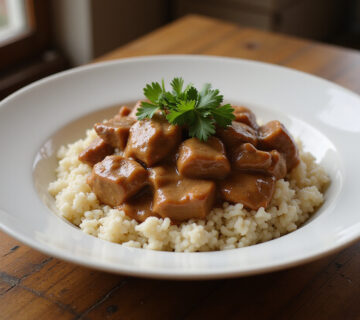
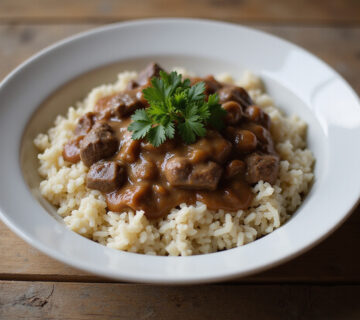
No comment